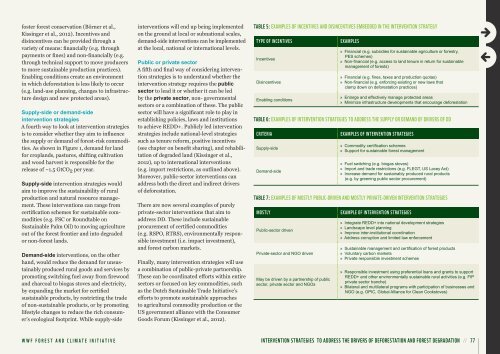WWF Guide to Building REDD+ Strategies
WWF Guide to Building REDD+ Strategies
WWF Guide to Building REDD+ Strategies
You also want an ePaper? Increase the reach of your titles
YUMPU automatically turns print PDFs into web optimized ePapers that Google loves.
foster forest conservation (Börner et al.,<br />
Kissinger et al., 2012). Incentives and<br />
disincentives can be provided through a<br />
variety of means: financially (e.g. through<br />
payments or fines) and non-financially (e.g.<br />
through technical support <strong>to</strong> move producers<br />
<strong>to</strong> more sustainable production practices).<br />
Enabling conditions create an environment<br />
in which deforestation is less likely <strong>to</strong> occur<br />
(e.g. land-use planning, changes <strong>to</strong> infrastructure<br />
design and new protected areas).<br />
Supply-side or demand-side<br />
intervention strategies<br />
A fourth way <strong>to</strong> look at intervention strategies<br />
is <strong>to</strong> consider whether they aim <strong>to</strong> influence<br />
the supply or demand of forest-risk commodities.<br />
As shown in Figure 1, demand for land<br />
for croplands, pastures, shifting cultivation<br />
and wood harvest is responsible for the<br />
release of ~1.5 GtCO2 per year.<br />
Supply-side intervention strategies would<br />
aim <strong>to</strong> improve the sustainability of rural<br />
production and natural resource management.<br />
These interventions can range from<br />
certification schemes for sustainable commodities<br />
(e.g. FSC or Roundtable on<br />
Sustainable Palm Oil) <strong>to</strong> moving agriculture<br />
out of the forest frontier and in<strong>to</strong> degraded<br />
or non-forest lands.<br />
Demand-side interventions, on the other<br />
hand, would reduce the demand for unsustainably<br />
produced rural goods and services by<br />
promoting switching fuel away from firewood<br />
and charcoal <strong>to</strong> biogas s<strong>to</strong>ves and electricity,<br />
by expanding the market for certified<br />
sustainable products, by restricting the trade<br />
of non-sustainable products, or by promoting<br />
lifestyle changes <strong>to</strong> reduce the rich consumer’s<br />
ecological footprint. While supply-side<br />
<strong>WWF</strong> FOREST AND CLIMATE INITIATIVE<br />
interventions will end up being implemented<br />
on the ground at local or subnational scales,<br />
demand-side interventions can be implemented<br />
at the local, national or international levels.<br />
Public or private sec<strong>to</strong>r<br />
A fifth and final way of considering intervention<br />
strategies is <strong>to</strong> understand whether the<br />
intervention strategy requires the public<br />
sec<strong>to</strong>r <strong>to</strong> lead it or whether it can be led<br />
by the private sec<strong>to</strong>r, non- governmental<br />
sec<strong>to</strong>rs or a combination of these. The public<br />
sec<strong>to</strong>r will have a significant role <strong>to</strong> play in<br />
establishing policies, laws and institutions<br />
<strong>to</strong> achieve <strong>REDD+</strong>. Publicly led intervention<br />
strategies include national-level strategies<br />
such as tenure reform, positive incentives<br />
(see chapter on benefit sharing), and rehabilitation<br />
of degraded land (Kissinger et al.,<br />
2012), up <strong>to</strong> international interventions<br />
(e.g. import restrictions, as outlined above).<br />
Moreover, public-sec<strong>to</strong>r interventions can<br />
address both the direct and indirect drivers<br />
of deforestation.<br />
There are now several examples of purely<br />
private-sec<strong>to</strong>r interventions that aim <strong>to</strong><br />
address DD. These include sustainable<br />
procurement of certified commodities<br />
(e.g. RSPO, RTRS), environmentally responsible<br />
investment (i.e. impact investment),<br />
and forest carbon markets.<br />
Finally, many intervention strategies will use<br />
a combination of public-private partnership.<br />
These can be coordinated efforts within entire<br />
sec<strong>to</strong>rs or focused on key commodities, such<br />
as the Dutch Sustainable Trade Initiative’s<br />
efforts <strong>to</strong> promote sustainable approaches<br />
<strong>to</strong> agricultural commodity production or the<br />
US government alliance with the Consumer<br />
Goods Forum (Kissinger et al., 2012).<br />
taBle 5: examPleS oF inCentiveS and diSinCentiveS emBedded in tHe inteRvention StRateGy<br />
tyPe oF inCentiveS examPleS<br />
Incentives<br />
Disincentives<br />
Enabling conditions<br />
» Financial (e.g. subsidies for sustainable agriculture or forestry,<br />
PES schemes)<br />
» Non-financial (e.g. access <strong>to</strong> land tenure in return for sustainable<br />
management of forests)<br />
» Financial (e.g. fines, taxes and production quotas)<br />
» Non-financial (e.g. enforcing existing or new laws that<br />
clamp down on deforestation practices)<br />
» Enlarge and effectively manage protected areas<br />
» Minimize infrastructure developments that encourage deforestation<br />
taBle 6: examPleS oF inteRvention StRateGieS <strong>to</strong> addReSS tHe SuPPly oR demand oF dRiveRS oF dd<br />
CRiteRia examPleS oF inteRvention StRateGieS<br />
Supply-side<br />
Demand-side<br />
» Commodity certification schemes<br />
» Support for sustainable forest management<br />
» Fuel switching (e.g. biogas s<strong>to</strong>ves)<br />
» Import and trade restrictions (e.g. FLEGT, US Lacey Act)<br />
» Increase demand for sustainably produced rural products<br />
(e.g. by greening public sec<strong>to</strong>r procurement)<br />
taBle 7: examPleS oF moStly PuBliC-dRiven and moStly PRivate-dRiven inteRvention StRateGieS<br />
moStly examPle oF inteRvention StRateGieS<br />
Public-sec<strong>to</strong>r driven<br />
Private-sec<strong>to</strong>r and NGO driven<br />
May be driven by a partnership of public<br />
sec<strong>to</strong>r, private sec<strong>to</strong>r and NGOs<br />
» Integrate <strong>REDD+</strong> in<strong>to</strong> national development strategies<br />
» Landscape level planning<br />
» Improve inter-institutional coordination<br />
» Address corruption and limited law enforcement<br />
» Sustainable management and certification of forest products<br />
» Voluntary carbon markets<br />
» Private responsible investment schemes<br />
» Responsible investment using preferential loans and grants <strong>to</strong> support<br />
<strong>REDD+</strong> and other environmentally sustainable rural activities (e.g. FIP<br />
private sec<strong>to</strong>r tranche)<br />
» Bilateral and multilateral programs with participation of businesses and<br />
NGO (e.g. OPIC, Global Alliance for Clean Cooks<strong>to</strong>ves)<br />
inteRvention StRateGieS <strong>to</strong> addReSS tHe dRiveRS oF deFoReStation and FoReSt deGRadation // 77

















